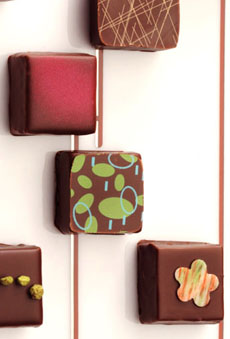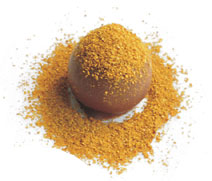 
These gorgeous bonbons from Jin Patisserie of Venice, California, a NIBBLE Top Pick Of The Week, bear zero resemblance to the chocolate first experienced by the Spanish Conquistadors. These: among the most delicious confections in America, are filled with fondant flavors like Ginger, Green Jasmine, Lemongrass and Roasted Black Sesame. The original chocolate was also exotic, but a bitter, unsweetened beverage mixed with pepper, chili pepper, musk, vanilla and cornmeal. It was enjoyed by the Aztecs but so unpalatable to the Europeans, they spat it on the ground.
|
KAREN HOCHMAN’s first word was not cacahuatl...but as her mother will attest, it was pretty close.
|
|
August 2005
Updated January 2009
|
 |
From Pod to Palate Part I: A Brief History Of Chocolate
Page 4: The First Chocolate Bar
This is Page 4 of a four-page article. Click on the black links below to visit other pages.
The First Chocolate Bar
The first chocolate bars date to 1847 to Joseph Fry & Son in Bristol, England. In 1789, Fry had purchased a Watts steam engine to grind cacao; but it wasn’t until 58 years later that his great-grandson thought to see what happened if he mixed some of the pressed cocoa butter back along with some sugar back into the dutch cocoa cakes. He pressed the mixture into a mold, and the chocolate bar—then called “eating chocolate” to distinguish it from “drinking chocolate” was born.
Continued industrial inventions enabled an expansion in efficient production of chocolate bars, which increased their availability and variety (including the inspired addition of nuts). Cocoa powder enabled the addition of chocolate to recipes: In 1866 chocolate cream desserts and cookies appeared in British shops. Milk chocolate was invented in 1875 by Daniel Peter of Vevey, Switzerland, who finally solved the problem that had vexed many by mixing chocolate with powdered milk instead of whole milk or cream.

The milk chocolate Naga truffles from
Chicago’s Vosges Haut Chocolat is flavored
with sweet Indian curry and coconut.
By the 20th century, chocolatiers had mastered the transformation of chocolate into the sophisticated repertoire we enjoy today. The first filled chocolates were created by Séchaud Fils in Montreaux, Switzerland in 1913. The first white chocolate was manufactured by Nestlé in the 1930s. Truffles, bonbons with fillings, ganache (mixed cream and chocolate), chocolate bars in myriad varieties, chocolate-covered specialties from glazed fruit to coffee beans, molded and sculpted chocolates of every description, filled the chocolate shops of the world.
With the complexity of flavors and aromas in fine chocolates (as many as 400 different aromas and flavors have been identified), chocolate connoisseurship now can be equated to wine connoisseurship on several levels.
As with vineyards, the soil and microclimate of each plantation or growing area provide distinct flavors and aromas, which also are impacted by the harvest’s particular weather conditions. In 1984 the first chocolate bars to designate the region of origin of the bean were introduced. Now the best bars of some fine manufacturers are designated by their specific plantations (“pure origin”); and some are even designated by their harvest years. As Americans have developed their preferences for wine beyond “red” and “white,” so too are chocolate lovers educating themselves beyond “dark” and “milk.”
The century ended with the celebration of “nouvelle” chocolates. Chocolatiers have provided chocolate-lovers with combinations beyond the traditional additions of fruits and nuts. Now, there you can have both couverture and fillings infused with international flavors like wasabi, saffron, lavender, anise, paprika, curry, peppercorns and Ancho chili—proving that everything old is new again.
Continue to Part II: The Birth Of The Bar (See How Chocolate Is Produced)
Go To The Article Index Above

|





